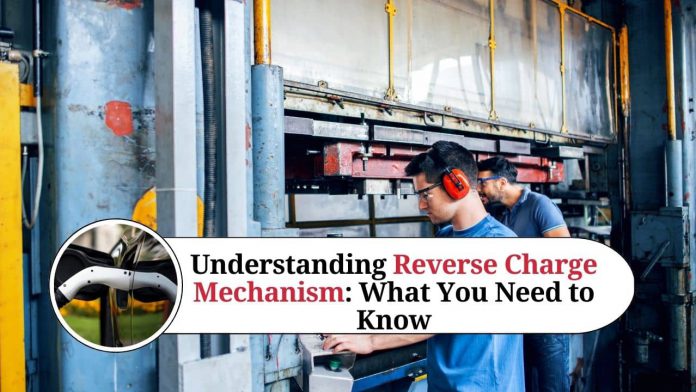Reverse Charge Mechanism: An Overview
In the field of taxation, reverse charge mechanism refers to a system where the recipient of goods or services is liable to pay the tax, instead of the supplier. This is a departure from the traditional system where the supplier is responsible for paying the tax on the supply of goods or services. The reverse charge mechanism is an important tool for tax administration, especially in the case of goods and services that are difficult to track and regulate.
Reverse Charge Mechanism: Working and Implementation
In the reverse charge mechanism, the recipient of goods or services is required to pay the tax directly to the government, instead of the supplier. This is usually done through a self-invoicing process, where the recipient generates an invoice for the goods or services received, and includes the tax amount in the invoice. The recipient then pays the tax amount to the government, along with their regular tax payments.
The reverse charge mechanism is typically implemented for goods and services that are difficult to regulate or track, such as construction services, goods and services provided by unregistered dealers, and imports of goods and services. The mechanism is also used to prevent tax evasion and ensure that all taxable transactions are accounted for.
Reverse Charge Mechanism: Advantages and Disadvantages
The reverse charge mechanism has several advantages for tax administration. It allows for better tracking and regulation of goods and services that are difficult to monitor, and helps prevent tax evasion by unregistered dealers. It also reduces the administrative burden on small suppliers who would otherwise have to register for and pay taxes.
However, the reverse charge mechanism can also have some disadvantages. It can increase the compliance burden on recipients of goods and services, who may not have the expertise or resources to accurately calculate and pay the tax amount. It can also lead to cash flow problems for small businesses, who may struggle to pay the tax amount upfront.
Reverse Charge Mechanism: Applicability and Exemptions
The reverse charge mechanism is not applicable to all goods and services. It is typically implemented for specific categories of goods and services that are difficult to regulate, such as construction services, goods and services provided by unregistered dealers, and imports of goods and services.
There are also exemptions to the reverse charge mechanism, which vary by jurisdiction. In some cases, certain goods and services may be exempt from the reverse charge mechanism if they are provided by small businesses or if the value of the transaction is below a certain threshold.
Examples of Goods and Services Covered Under Reverse Charge Mechanism
The reverse charge mechanism is typically implemented for specific categories of goods and services that are difficult to regulate and monitor. Some common examples of goods and services covered under reverse charge mechanism include:
- Construction Services: Services provided by contractors, builders, and other construction-related services are typically covered under reverse charge mechanism. This is because it can be difficult to regulate and monitor the quality of construction services and track the movement of construction materials.
- Unregistered Dealers: Goods and services provided by unregistered dealers or suppliers are often covered under reverse charge mechanism. This helps prevent tax evasion and ensures that all taxable transactions are accounted for.
- Imports of Goods and Services: Imports of goods and services are also commonly covered under reverse charge mechanism. This is because it can be difficult to track the movement of imported goods and services and ensure that the appropriate taxes are paid.
- Transportation Services: Transportation services provided by unregistered transporters are also covered under reverse charge mechanism. This helps prevent tax evasion and ensures that all taxable transactions related to transportation are accounted for.
Exemptions to Reverse Charge Mechanism
While the reverse charge mechanism is an important tool for tax administration, there are exemptions to this system that vary by jurisdiction. Some common exemptions to reverse charge mechanism include:
- Small Businesses: In some jurisdictions, small businesses may be exempt from the reverse charge mechanism if their turnover is below a certain threshold. This helps reduce the compliance burden on small businesses and encourages them to participate in the formal economy.
- Certain Goods and Services: Certain goods and services may also be exempt from reverse charge mechanism. For example, essential goods and services such as healthcare and education may be exempt from the reverse charge mechanism in some jurisdictions.
- Inter-state Transactions: In some cases, inter-state transactions may be exempt from the reverse charge mechanism. This is because the tax liability is already being handled through the Integrated Goods and Services Tax (IGST) system, which is a combination of the Central Goods and Services Tax (CGST) and State Goods and Services Tax (SGST).
Impact of Reverse Charge Mechanism on Small Businesses
While the reverse charge mechanism is an effective tool for tax administration, it can have a significant impact on small businesses. Small businesses may face a higher compliance burden, increased administrative costs, and cash flow problems when they are required to pay tax under the reverse charge mechanism. This is because small businesses may not have the resources or expertise to accurately calculate and pay the tax amount. To mitigate the impact of the reverse charge mechanism on small businesses, some jurisdictions provide exemptions or thresholds based on turnover or the value of the transaction. These exemptions can help reduce the compliance burden and cash flow problems faced by small businesses.
Conclusion
The reverse charge mechanism is an important tool for tax administration, especially in the case of goods and services that are difficult to regulate and monitor. While it has some advantages, such as better tracking and regulation, it can also have some disadvantages, such as increased compliance burden and cash flow problems for small businesses. Overall, the reverse charge mechanism is an important tool for ensuring that all taxable transactions are accounted for and that tax evasion is prevented.
Read more useful content:
Frequently Asked Questions (FAQ’s)
Q1.) What is reverse charge mechanism?
The reverse charge mechanism is a system where the recipient of goods or services is responsible for paying the tax instead of the supplier.
Q2.) Who is responsible for paying the tax under the reverse charge mechanism?
The recipient of goods or services is responsible for paying the tax under the reverse charge mechanism.
Q3.) Which goods and services are covered under the reverse charge mechanism?
The reverse charge mechanism typically applies to specific categories of goods and services that are difficult to regulate and monitor, such as construction services, transportation services provided by unregistered transporters, imports of goods and services, and goods and services provided by unregistered dealers.
Q4.) How does the reverse charge mechanism work in practice?
Under the reverse charge mechanism, the recipient of goods or services calculates and pays the tax amount on behalf of the supplier. The supplier does not charge tax on their invoice, but the recipient adds the tax amount to their own tax return.
Q5.) Is the reverse charge mechanism mandatory for all goods and services?
The reverse charge mechanism is not mandatory for all goods and services. It typically applies to specific categories of goods and services that are difficult to regulate and monitor.
Q6.) Are there any exemptions to the reverse charge mechanism?
Yes, there are exemptions to the reverse charge mechanism that vary by jurisdiction. Some common exemptions include small businesses, certain goods and services, and inter-state transactions.
Q7.) What are the advantages of the reverse charge mechanism?
The reverse charge mechanism is an effective tool for tax administration, as it helps prevent tax evasion and ensures that all taxable transactions are accounted for.
Q8.) What are the disadvantages of the reverse charge mechanism?
The reverse charge mechanism can have a significant impact on small businesses, as they may face a higher compliance burden, increased administrative costs, and cash flow problems when they are required to pay tax under the reverse charge mechanism.
Q9.) How can small businesses manage the impact of the reverse charge mechanism?
Small businesses can manage the impact of the reverse charge mechanism by keeping accurate records, understanding exemptions and thresholds, monitoring cash flow, and seeking professional advice.
Q10.) What is the difference between reverse charge mechanism and forward charge mechanism?
Under the forward charge mechanism, the supplier of goods or services is responsible for paying the tax. Under the reverse charge mechanism, the recipient of goods or services is responsible for paying the tax.




















